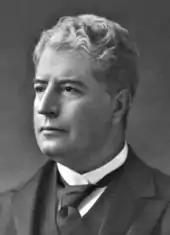1901 in Australia
The following lists events that happened during 1901 in Australia.
| 1901 in Australia | |
|---|---|
| Monarchy | Victoria, then Edward VII |
| Governor-General | Lord Hopetoun |
| Prime minister | Edmund Barton |
| Population | 3,788,123 |
| Elections | Federal, WA, NSW |
| |||||
| Decades: |
| ||||
|---|---|---|---|---|---|
| See also: | |||||
Incumbents
- Monarch – Victoria (until 22 January), then Edward VII
- Governor-General – Lord Hopetoun (from 1 January)
- Prime Minister – Edmund Barton (from 1 January)
- Opposition Leader – George Reid (from 19 May)
State Leaders
- Premier of New South Wales – William Lyne (until 27 March), then John See
- Opposition Leader – Charles Lee (from 23 March)
- Premier of Queensland – Robert Philp
- Opposition Leader – Anderson Dawson (until 16 July), then Billy Browne
- Premier of South Australia – Frederick Holder (until 15 May), then John Jenkins
- Premier of Tasmania – Elliott Lewis
- Opposition Leader – Sir Edward Braddon (until March), then Sir Thomas Reibey (until October), then William Propsting
- Premier of Victoria – Sir George Turner (until 12 February), then Alexander Peacock
- Premier of Western Australia – Sir John Forrest (until 15 February), then George Throssell (until 27 May), then George Leake (until 21 November), then Alf Morgans (until 23 December), then George Leake
Governors and Administrators
- Governor of New South Wales – The Earl Beauchamp (until 30 April)
- Governor of Queensland – Lord Lamington (until 19 December)
- Governor of South Australia – Lord Tennyson
- Governor of Tasmania – Sir Arthur Havelock (from 8 November)
- Governor of Victoria – Sir George Clarke (from 10 December)
- Governor of Western Australia – Baron Wetlock (from 1 May)
- Government Resident of the Northern Territory – Charles Dashwood
Events
- 1 January – The Constitution of Australia comes into force, as the federation of Australia is complete. John Adrian Louis Hope, 7th Earl of Hopetoun, is appointed as the first Governor-General, and Edmund Barton as the first Prime Minister.
- 1 March – Following federation naval and military forces of the States are transferred to Commonwealth control.
- 29 March – The first federal election is held to elect the first members of the House of Representatives and the first members of the Senate.
- 31 March – A national census is held, which indicates the population of Australia is 3,773,801 (excluding Indigenous Australians).
- 9 May – The Parliament of Australia is opened in the Royal Exhibition Building, Melbourne.
- 22 May – The foundation stone for St John's Cathedral, Brisbane is laid by The Duke of Cornwall and York (later George V). the church celebrated 100 years of construction in 2006 and is only gothic-style stone building under construction anywhere in the world.
- 3 September – The Flag of Australia and Australian Red Ensign are adopted by the Government of Australia as official flags, following a national design competition.
- 21 December – Construction begins on the rabbit-proof fence.
- 23 December – The Immigration Restriction Act 1901 comes into force, instituting the White Australia Policy.
Sport
- 3 January – Victoria wins the Sheffield Shield.[1]
- 28 September – Essendon beats Collingwood 6.7 (43) to 2.4 (16) in the 1901 VFL grand final
- 5 November – Revenue wins the Melbourne Cup.[2]
Literature
Births
- 27 March – Kenneth Slessor, poet (d. 1971)
- 1 June – Tom Gorman, rugby league footballer (d. 1978)
Deaths
- 10 January – James Dickson (b. 1832), politician, 13th Premier of Queensland
- 8 August – William Henry Groom (b. 1833), politician
References
- "Old Boy": Interstate Cricket—Victoria Wins the Sheffield Shield, The Argus, 4 January 1901
- The Melbourne Cup, The Advertiser, 6 November 1901
This article is issued from Wikipedia. The text is licensed under Creative Commons - Attribution - Sharealike. Additional terms may apply for the media files.
